
About UsThe Numismatic Bibliomania Society is a non-profit organization promoting numismatic literature. For more information please see our web site at coinbooks.org SubscriptionsThose wishing to become new E-Sylum subscribers (or wishing to Unsubscribe) can go to the following web page link MembershipThere is a membership application available on the web site Membership Application To join, print the application and return it with your check to the address printed on the application. Membership is only $15 to addresses in the U.S., $20 for First Class mail, and $25 elsewhere. For those without web access, write to: David M. Sundman, Secretary/TreasurerNumismatic Bibliomania
Society AsylumFor Asylum mailing address changes and other membership questions, contact David at this email address: dsundman@LittletonCoin.com SubmissionsTo submit items for publication in The E-Sylum, just Reply to this message, or write to the Editor at this address: whomren@coinlibrary.com
BUY THE BOOK BEFORE THE COINYou won't regret it! |
- WAYNE'S WORDS: THE E-SYLUM NOVEMBER 20, 2011
- KOLBE & FANNING NUMISMATIC LITERATURE SALE JANUARY 7, 2012
- KARL MOULTON WINTER/SPRING 2011 FIXED PRICE LIST ISSUED
- KRAUSE PUBLICATIONS WAREHOUSE SALE EXTENDED
- NEW BOOK: FORTRESS OF FINANCE: THE U.S. TREASURY BUILDING
- NEW BOOK: ONE OF A KIND - A NOVEL ABOUT THE 1873-S DOLLAR
- NEW BOOK: PEACE MEDALS: NEGOTIATING POWER IN EARLY AMERICA
- BOOK REVIEW: CHERRYPICKERS' GUIDE TO RARE DIE VARIETIES OF UNITED STATES COINS
- ONLINE EXHIBIT: AUCTION CATALOGS IN THE ANS LIBRARY
- COLONIAL COIN COLLECTORS CLUB 2011 LITERATURE SALE RESULTS
- NUMISMATIC AUCTIONS LLC REACHES MILESTONE
- QUERY: ENGRAVER SIGNATURES ON DIE PRESSED WOODEN EXONUMIA
- WHY DON'T MORE COUNTRIES USE POLYMER BANKNOTES?
- NOTES FROM E-SYLUM READERS: NOVEMBER 20, 2011
- MIMI BIZIC AND THE HOBO NICKELS BOOK
- QUIZ ANSWERS: RAY WILLIAMS' MYSTERY MARKS
- HACKNEY HOARD OF U.S. DOUBLE EAGLES TO BE SOLD
- THE EURO'S STRANGE STORIES
- NUMISMATICS IN THE BASEL HISTORICAL MUSEUM'S NEW EXHIBITS
- ONLINE TRANSACTION FIRM DWOLLA SIDESTEPS CREDIT CARD NETWORKS
- MALAWI WOMAN DELIVERS BOUNCING BABY BANKNOTE
- FEATURED WEB SITE: ARTMEDAL.BE
WAYNE'S WORDS: THE E-SYLUM NOVEMBER 20, 2011

Not surprisingly, there was a large response to last week's announcement of the Quarterman Publications warehouse sale. The sale ends with this issue of The E-Sylum.
Dave Hoch writes:
I really appreciate the orders, and my dad would be happy that there was such a great response. Many of you also included some kind words, regarding his quality of books and his integrity. Thank you.
Among our new subscribers this week are new part-time ANS library cataloguer Michael Guerra, courtesy of ANS Librarian Elizabeth Hahn, and Diego Bolaρos. Welcome aboard! We have 1,473 email subscribers, plus 167 followers on Facebook.
This week we open with items about three numismatic literature sales, three new numismatic (or numismatic-related) books, and a book review. Wow! And in still more book news we have items on a new ANS library online exhibit and results of sales of nice numismatic literature in the C4 club auction.
Other topics this week include polymer banknotes, Hobo Nickels, and the Hackney Hoard of U.S. double eagles.
To learn more about the U.S. Treasury building, the 1742 Harley catalog, the 1873-S dollar and why more countries don't use polymer notes, read on. Have a great week, everyone!
Wayne Homren
Numismatic Bibliomania Society
KOLBE & FANNING NUMISMATIC LITERATURE SALE JANUARY 7, 2012
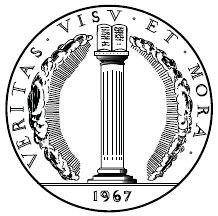 "Small but Mighty" might be a good phrase to describe the January 7, 2012 Kolbe & Fanning public auction of rare and desirable numismatic works to be sold in conjunction with the New York International Numismatic Convention in New York City at the Waldorf Astoria Hotel. While there are only 350 lots in the sale, total estimates come to nearly $500,000 and, for the first time, K & F will offer free live internet bidding. Selected lots will be available for viewing at the Waldorf on the Thursday, Friday and Saturday morning preceding the sale.
"Small but Mighty" might be a good phrase to describe the January 7, 2012 Kolbe & Fanning public auction of rare and desirable numismatic works to be sold in conjunction with the New York International Numismatic Convention in New York City at the Waldorf Astoria Hotel. While there are only 350 lots in the sale, total estimates come to nearly $500,000 and, for the first time, K & F will offer free live internet bidding. Selected lots will be available for viewing at the Waldorf on the Thursday, Friday and Saturday morning preceding the sale.
Some sale highlights include:
Morton Stack's deluxe three-volume set of photographs depicting Colonel E.H.R. Green's fabled collection of United States gold quarter eagles, half eagles and eagles
A nice example of the first printed book, Guillaume Budι's landmark 1514 De asse et partibus eius
One of only two known surviving copies of F.C.C. Boyd's inventory and appraisal of the legendary Col. E.H.R. Green collection, this being the only copy known that is notarized and signed by Boyd
Dr. Jacob Hirsh's unique annotated set of 164 proof plates depicting the original Pozzi collection of ancient Greek coins
Thomas Jefferson's remarkable 1790 Report on the Weights, Measures and Coins of the United States, a foundational document in American numismatics
A remarkable archive of over 100 White proof bank notes from the Russian Civil War, a number of them unrecorded in Istomin
A spectacular Bureau of Engraving and Printing Vignette Book, in oversize format, with a lavishly deluxe binding and featuring well over 200 steel-plate printed BEP portraits and vignettes
An exceptional, complete set of Visconti and Mongez's massive and "glorious" 180826 Iconographie grecque et romaine
Over two dozen original plated Chapman brother sales, generally in excellent condition, including Henderson, Stickney, Siedlecki, Zabriskie, Taylor & Windle, Jenks, and Gable
A small selection of rare Russian numismatic works
A number of rare and important titles on Renaissance and other medals
Classic works on ancient coins, including Haeberlin's Aes Grave, sets of Rasche, Pellerin, and Eckhel, SNG von Aulock, and other key works
A delightful 1720 manuscript on coin collecting by David Jennings, apparently the precursor to his work published years later by the Baskervilles
Enea Vico's first numismatic work and a remarkable preliminary printer's mock-up of his 1558 Augustarum imagines
A complete set of American Numismatic Society Numismatic Notes and Monographs
The unique bid books of the four part 19261929 Schulman sales of the Count Ferrari collection of modern German coins
Rare works on paper money and counterfeit detection including Ibbetson's 1850s title on circular turning, a run of Hodges' Bank Note Safeguards, and early bank note reporters
Rare works and manuscripts on American colonial numismatics, several from the library of George C. Perkins
Seven original Latin American works by J.T. Medina
And much, much more.
An illustrated version of the catalogue should be available by November 18th or earlier at the firm's website: www.numislit.com
A full color illustrated catalogue may be obtained by sending $35 to: KOLBE & FANNING NUMISMATIC BOOKSELLERS LLC, 141 W JOHNSTOWN ROAD, GAHANNA OH 43230-2700.
Kolbe & Fanning wishes to thank the many customers, both new and old, who have placed orders on the firm's recently upgraded and modernized website at www.numislit.com. The site features easy payment options and a substantial listing of numismatic literature available for outright sale, which will be augmented on a regular basis.
KARL MOULTON WINTER/SPRING 2011 FIXED PRICE LIST ISSUED
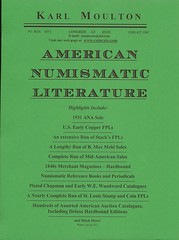 Karl Moulton has issued his Winter/Spring 2011 fixed price list of numismatic literature. Highlights include a 1931 American Numismatic Association convention sale catalogue, a lengthy run of B. Max Mehl catalogs, and plated Chapman and Woodward catalogues.
Karl Moulton has issued his Winter/Spring 2011 fixed price list of numismatic literature. Highlights include a 1931 American Numismatic Association convention sale catalogue, a lengthy run of B. Max Mehl catalogs, and plated Chapman and Woodward catalogues.
For more information, see: www.coincats.com
KRAUSE PUBLICATIONS WAREHOUSE SALE EXTENDED
It's the sale of the century! 11-11-11 only happens once every hundred years! So to celebrate, we are having a once-in-a-lifetime warehouse sale like none other! From 11/11/11 to 11/13/11, we've selected hundreds of great products and are offering them to you virtually at cost! Throughout the stores listed below, you can choose from more than 500 titles all priced at just $3.99 and $4.99. Quantities are limited, so don't delay you don't want to miss this one-time opportunity to save! No promo codes are needed at checkout, just shop and save!

To see the numismatic titles, visit:
Numismatics Warehouse Sale
(www.shopnumismaster.com/category/numismatics-
warehouse-sale/?r=111111SALE)
NEW BOOK: FORTRESS OF FINANCE: THE U.S. TREASURY BUILDING
David Sundman writes:
I am a member of the Treasury Historical Association and bought this book when it first came out, but haven't had the time to read it yet. It is an exceptional work and worth the price for the photos alone, many of the Treasury building and Washington DC that are rarely seen.
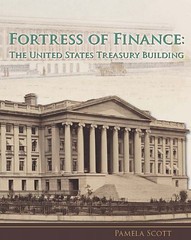 Fortress of Finance: The United States Treasury Building, the Treasury Historical Association's
award-winning book on the history of the National Historic Landmark Treasury
Building next to the White House and the predecessor Treasury Office is the result of over
eight years of research by architectural historian Pamela Scott, author of Temple of Liberty,
a history of the U.S. Capitol Building, and co-author of Buildings of the District of Columbia.
Fortress of Finance: The United States Treasury Building, the Treasury Historical Association's
award-winning book on the history of the National Historic Landmark Treasury
Building next to the White House and the predecessor Treasury Office is the result of over
eight years of research by architectural historian Pamela Scott, author of Temple of Liberty,
a history of the U.S. Capitol Building, and co-author of Buildings of the District of Columbia.
She has developed a captivating account of the construction of the Building and its unique architectural features that have made it one of Washington, DC's most magnificent structures. The book includes an appendix with a summary of histories of the Treasury's current bureaus and those now in other departments and agencies.
Fortress of Finance: The United States Treasury Building . . .
Received Independent Publishers' second-place award in 2010 Mid-Atlantic Non-Fiction category of books.
Is a substantial hardback book, over 3 pounds, about 8-1/2 by 11 inches, with 336 pages, printed on high-quality matte coated paper, with wrap-around illustrated heavy paper dustcover.
Contains 185 images of historic drawings, blueprints, etchings, paintings and photographs, ranging from sepia, black-and-white and color-tinted to 21st-century full-color digital images.
Has an elegant "leather-effect" case wrap, gold-stamp title on front and spine, with sections of the book) stitched to the binding, for long lasting quality of the book.
Can serve as a great Christmas or holiday gift for yourself or others. The regular retail price for Fortress of Finance is $55.00, plus $5.00 shipping and handling. However, THA Members will be given Free Shipping OR a Free Gold-Finished Treasury Building Bookmark for orders placed through December 5, 2011 only.
To order, see: www.treasuryhistoricalassn.org/newsletters/Advertisement7P.pdf
THE BOOK BAZARRE
NEW BOOK: ONE OF A KIND - A NOVEL ABOUT THE 1873-S DOLLAR
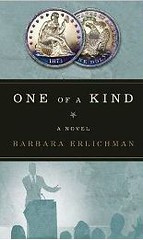 Could you build a story around the appearance of a fabled coin and make it an interesting read? We know there are true stories about the 1913 Liberty Head nickels and the 1933 Saint-Gaudens Double Eagles. But what would happen if the little known 1873-S Seated Liberty Dollar was discovered and put up for auction?
Could you build a story around the appearance of a fabled coin and make it an interesting read? We know there are true stories about the 1913 Liberty Head nickels and the 1933 Saint-Gaudens Double Eagles. But what would happen if the little known 1873-S Seated Liberty Dollar was discovered and put up for auction?
Numismatists know that the Coinage Act of 1873 put the United States on the gold standard and demonetized silver. This law hurt western mining interests who wanted both gold and silver to remain in circulation. It became known as the "Crime of '73."
At the U.S. Mint, the branch mint in San Francisco reported that it struck 700 Seated Liberty Coins but none have ever surfaced. What happened if one was found that was a heirloom of a rich family from the west coast? Then what would happen if the patriarch dies, wills the coin to a maid/personal assistant who then consigns it to an auction that attracts worldwide attention. This is the premise of the novel One of a Kind by Barbara Erlichman.
According to her bio, Barbara Erlichman was raised in England and came to the United States intending to work her way across America. Arriving in New York, she met her future husband and they started a rare coin business. Based in New York, they traveled throughout the United States and Europe buying coins and collectibles. When she contacted me about her book, she and her husband retired to Florida and this this is her first book.
To read the complete blog article, see: BOOK REVIEW: One of a Kind (coinsblog.blogspot.com/2011/11/book-review-one-of-kind.html)
To order the book on Amazon.com, see: One of a Kind
NEW BOOK: PEACE MEDALS: NEGOTIATING POWER IN EARLY AMERICA
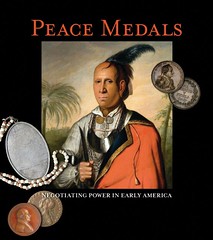 "Peace and Friendship" these powerful words are emblazoned on the back of silver peace medals given by American presidents to chiefs of important Native American tribes in the 18th and 19th centuries.
"Peace and Friendship" these powerful words are emblazoned on the back of silver peace medals given by American presidents to chiefs of important Native American tribes in the 18th and 19th centuries.
The U.S. government negotiated with powerful chiefs to secure their political allegiance against other colonial powers (Great Britain, France and Spain) and to create trading partnerships. "Peace and friendship" was a noble phrase, but one that that rarely described the real interactions between the government and Native tribes.
Beautiful examples of the artistry of coins and medals, these peace medals selected from the Gilcrease collection are most notable for their historical significance. They serve as important symbols of the turbulent times that saw the birth of the American nation and its rise to world prominence. Peace medals also represent promises, kept and broken, made by our government to Indian peoples across the continent.
To read the complete article, see: Peace Medals: Symbols of Influence and Prestige in North America (www.gilcrease.utulsa.edu/Explore/Exhibits/Future-Exhibits/Peace-Medals)
Peace Medals
Negotiating Power In Early America
Contributions By: John W. Adams, Bruce W. Arnold, George J. Fuld, Frank H. Goodyear III, Duane H. King, Skyler Liechty, Tony Lopez, F. Kent Reilly III, Barry D. Tayman
Edited By: Robert B. Pickering
ILLUSTRATIONS: 54 COLOR AND 17 B&W ILLUS.
PUBLISHED: 2012
HARDCOVER ISBN: 9780981979946
128 PAGES, 9" X 10"
The contributors, including numismatic historians, anthropologists, archaeologists, and museum curators, explore how the American government used the medals in negotiations with powerful chiefs to secure trading partnerships and political allegiance against European colonial powers, and also discusses British, French, and Spanish medals as part of European negotiating strategies to create Indian allies on the American continent. The origin of peace medals and their synchrony with tribal traditions demonstrate how these high-status emblems evolved, while an examination of medals in a contemporary context reveals their continuing historical importance.
Peace Medals is richly illustrated with paintings and historical photographs that depict rarely seen images of British, French, and Spanish medals in addition to a selection of American medals. Taken together, the articles provide an expansive view of medallic artistry from the eighteenth to the twentieth century and offer new insights into their history. Most of the images are from the extraordinary collections of the Gilcrease Museum.
To read the complete article, see: Peace Medals: Negotiating Power In Early America (www.oupress.com/ECommerce/Book/Detail/1651/peace%20medals)
BOOK REVIEW: CHERRYPICKERS' GUIDE TO RARE DIE VARIETIES OF UNITED STATES COINS
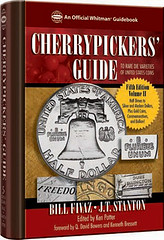 The Cherrypicker's Guide has grown over the years into two volumes, the latest issue is the Fifth Edition, Volume II. This contains information on varieties of coins starting with Half Dimes thru Dollar coinage and includes Gold, Commemoratives and Bullion issues.
The Cherrypicker's Guide has grown over the years into two volumes, the latest issue is the Fifth Edition, Volume II. This contains information on varieties of coins starting with Half Dimes thru Dollar coinage and includes Gold, Commemoratives and Bullion issues.
Anyone who collects varieties of the above coinage has been anxiously awaiting this publication. This volume sets the tone for collecting unusual varieties, because if a new coin is worthy of listing in this book then it is worth saving. The new edition does not disappoint, it includes new varieties that either did not exist or were not discovered since the last edition. It also has added some varieties that were not listed previously and can now be considered worthy of collecting.
As has been the standard of this book it includes excellent photographs of the coins selected for inclusion making it easy for both veteran and new collectors to identify the varieties listed.
There are three titles that are essential to current collectors of U.S. coins: The Guide Book of United States Coins (The Red Book), Walter Breen's Encyclopedia of Colonial and United States Coins and the Cherrypickers' Guide. Most of the questions a collector has about American coins can be answered by these books. If you are a specialist then a reference to your field of interest can be found in these books.
The first two titles try to explain information, attempting to be complete without going into extreme detail since they are for everyone and try to include all that is generally collected. The Cherrypicker's Guide does it differently - it only lists varieties of coins that need some examination to identify and are worth your attention to find.
The Cherrypicker's Guide once again makes coin collecting fun by making it possible to find noteworthy and valuable coins in change and in rolls of coins, thus bringing the adventure of collecting back to the young and curious next generation of collectors.
The Cherrypickers' Guide to Rare Die Varieties of United States Coins, fifth edition, volume II
By Bill Fivaz and J.T. Stanton; edited by Ken Potter; forewords by Q. David Bowers and Kenneth Bressett
ISBN 079483239-3
Spiralbound hardcover
512 pages
Retail $39.95
For more information, or to order, see: www.whitmanbooks.com/Default.aspx?Page=81&ProductID=0794832393
ONLINE EXHIBIT: AUCTION CATALOGS IN THE ANS LIBRARY
According to the November 20, 2011 issue of the ANS Enews from the American Numismatic Society:
In conjunction with the newly opened John W. Adams Rare Book Room exhibit, an online version of the exhibit "Lots of Lots: Auction Catalogs in the ANS Library" is now available.
More than 20,000 auction catalogs can be found in the ANS Library collections. The sheer size of this grouping is testament to their importance and, in fact, they are one of the most frequently consulted items. Aside from containing important information about the items in the sale, one reason these auction catalogs are so valuable and useful is that many contain contemporary handwriting that records the prices realized as well as the name of the buyer.
We see this in the earliest example in the collections, the Harley catalog from 1742. Auction catalogs help with die studies, tracing provenance and realized prices, rarity, and more. They also serve as a glimpse at coin collecting activity of the previous centuries and assist with identifying patterns of connoisseurship, locally and nationally, within the history of coin collecting and history. This exhibit is a very broad introduction to coin catalogs and dealers. The items on display illustrate some historically important auction dealers as well as the important collections that were being offered for sale.

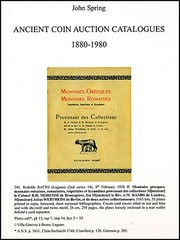 Adams, John W. United States numismatic literature. nineteenth century auction catalogs / Vol. 1 (1982). United States numismatic literature. twentieth century auction catalog, Vol. 2 (1990). Crestline, CA: George Frederick Kolbe Publications.
Adams, John W. United States numismatic literature. nineteenth century auction catalogs / Vol. 1 (1982). United States numismatic literature. twentieth century auction catalog, Vol. 2 (1990). Crestline, CA: George Frederick Kolbe Publications.
Spring, John. 2009. Ancient coin auction catalogues, 1880-1980. London: Spink.
Two of the best reference works about coin auction catalogs have been produced more recently. The two-volume work by John W. Adams is an excellent point of reference for information concerning United States auction catalogs from the 19th and 20th centuries. Biographies accompany the auction listings and a comprehensive chart grading auction importance is included along with other useful indexes. Although devoted specifically to ancient coin auction catalogs within a certain period, Spring's book is another thorough and comprehensive study including important dealer biographies, lists of significant sales, and numerous indexes that guide the researcher to understanding many of these sales. His listing includes 886 ancient coin auction catalogues that focus on only the most important sales within that 101 year period.
To read the complete online exhibit, see: Lots of Lots: Auction Catalogs in the ANS Library (numismatics.org/Library/Exhibit4Catalogs)
COLONIAL COIN COLLECTORS CLUB 2011 LITERATURE SALE RESULTS
On Saturday night of the C4 Convention in Boston (November 12th), C4 held a Donated Lots Auction, where all the proceeds were to go to the club. Every one of the 18 items auctioned were of interest but I thought I'd share a few of the literature items.
Heading the list in bids was the 5th Edition of Eric Newman's The Early Paper Money of America, which hammered at $1100! What made this book even more desirable than for its practical uses is that the author wrote a paragraph in the front, stating how this is the only copy he autographed on the actual day of his 100th Birthday!
The next was a copy of the Bowers & Ruddy Taylor Plates, copy #3, selling at $1000. With the first two copies going to the Taylor family, this makes this the most desirable of the limited edition issue.
Tied with the Taylor Plates in realizing a closing bid of $1000 was a copy of Tony Carlotto's The Copper Coins of Vermont. This book was the first of five books published by C4. Publishing is something we are very proud of as a club! This particular book was hand annotated in red ink by the author, giving new information since the book's release (1993) and the author's thoughts.
Next was a signed copy of The Silver Coins of Massachusetts signed by author Chris Salmon. This is one of the very limited copies that were bound in full leather by the author. The feeling of holding this book in your hands can only be appreciated by a bibliophile. This hammered at $500.
Also sold for $500 is a set of plates for attributing Nova Constellatios (by Carlotto), copies of the VT section of an annotated copy of the Coinage of New England, and several other plates.
And the last of the literature related items was one of 22 copies made of a book documenting the joint effort of C4 members, and the Museum Staff of the ANA, to place a six case Showcase Exhibit at the 2010 ANA Convention in Boston. Of the 22 copies made, most were given to the good people that lent their coins and material for the exhibit, the staff involved at the ANA, and to ANA, ANS & C4 Libraries. Every backpanel is plated. Every coin is plated and arranged in the chronological order that the cases displayed to the public. This book brought $350 for the benefit of C4.
I had a personal situation which necessitated me returning home before the auction, but I heard from friends that it was an outstanding success!
For more information on C4, see: http://www.colonialcoins.org/
JANUARY 7, 2012 NEW YORK AUCTION SALE
350 Lots Comprising a Remarkable Selection of OutstandingWorks on Ancient, Medieval and Modern Numismatics Featuring
RARE WORKS COVERING THE NUMISMATIC SPECTRUM
INCLUDING OVER TWO DOZEN PLATED CHAPMAN SALES
ORIGINAL COL. GREEN INVENTORY AND U.S. GOLD COIN ALBUMS
Catalogue Available at Our Web Site: www.numislit.com
Illustrated Catalogues $35.00
NUMISMATIC AUCTIONS LLC REACHES MILESTONE
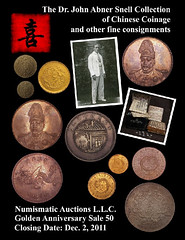 Stephen L. Davis of Lansing Michigan is celebrating his 50th numismatic auction next week under the banner of Numismatic Auctions LLC.
Stephen L. Davis of Lansing Michigan is celebrating his 50th numismatic auction next week under the banner of Numismatic Auctions LLC.
The firm grew from two co-workers at the auction firm headed by Joseph Lepczyk in the mid 1970s. For a brief time, that auction firm was owned by Downies of Australia. Later, in 1980, the pair, Craig A. Whitford. and Steve Davis, formed their own firm, auctioning numismatic items of all kinds.
Without specializing the firm flourished. They were just as comfortable offering ancient coins as U.S. commemoratives. Unfortunately Craig Whitford was in an auto accident in 2008, where a driver ran a red light and hit the auto Craig was driving, followed by a second similar accident. Craig had to reduce his activity and Steve took full control of Numismatic Auctions.
Craig went on to do postal history and Americana auctions after recovering. The pair not only remained friends they do cataloging for each other's auctions!
Steve's 50th sale features the Dr. John Abner Snell collection of Chinese coins. A missionary and medical doctor in China early in the century, the good doctor formed a collection of Oriental coins that had been stored away in a steamer trunk since 1936, on the death of the doctor in March 1936.
"It was a treat to open that trunk,' said Steve this week. Examining all those coins which hadn't been seen for 75 years was a real treat for this numismatist. They go on sale December 2nd.
As if conducting a mammoth 1120-lot auction was not activity enough next week, Steve is opening a second office, in Stockbridge, Michigan, one hour from Dearborn. I am hoping attendees of next week's Thanksgiving weekend convention will stop by for an open house, he said.
The firm's web site is: www.numismaticauctionsllc.com
The catalog listings are at: www.numismaticauctionsllc.com/Online_Catalog_Listings_PZ2.html
QUERY: ENGRAVER SIGNATURES ON DIE PRESSED WOODEN EXONUMIA

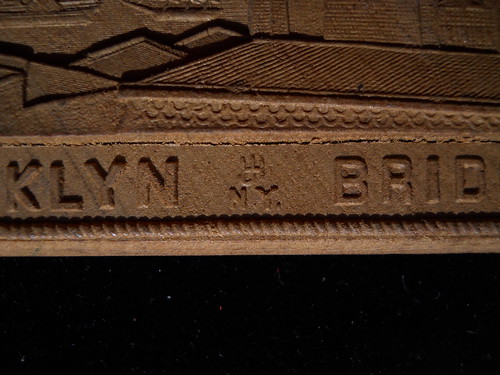
I thank you for your past help and kind offer to post my inquiry in The E-Sylum regarding the identity of the engraver/die sinker for two signatures.
Past contact with Hank Spangenberger & Dick Johnson has turned up no identification. More recent contact with David Alexander, Joe Levine, Ron Abler and Dave Bowers turned up no hunches, either.
I realize a general appeal is perhaps a long-shot but an attempt via your large email network is worthwhile.
On the attachments are pictures of the last two unidentified signatures/initials in my 30+ years of research on "Die Pressed Wooden Exonumia." Might anyone on your vast list have any hunch about the identity of either of these signatures?
Signature "A" appears on the 1876 Liberty Bell wooden plaquette.
Signature "B" appears on the 1883 Brooklyn Bridge wooden plaquette. (This signature is either a J superimposed on an H - or the other way around).
WHY DON'T MORE COUNTRIES USE POLYMER BANKNOTES?
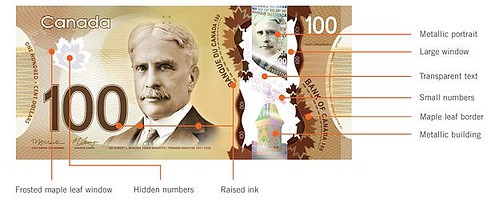
The Bank of Canada began circulating $100 polymer banknotes this week in an effort to combat counterfeiting and reduce costs. So why don't more countries use plastic cash?
On the face of it, plastic banknotes have many advantages.
They last a long time, and they don't get dirty so quickly - a great advantage in countries with hot climates, and sweaty pockets.
"The tropical climate is a challenging environment for banknotes, especially because of high humidity and high temperatures," says polymer researcher Stane Straus.
"This causes paper notes to absorb moisture, thus becoming dirty and limp quickly. Polymer notes, on the other hand, do not absorb moisture.
"You could say that polymer notes beat paper notes in terms of cleanliness and durability in all climates, but this particular advantage of polymer notes stands out even more in tropical climates."
Canada had security, cost and also the environment in mind when it took the decision to go plastic.
So why don't more countries cash in on this technology?
Today, 23 countries use polymer banknotes, but only six have converted all denominations into plastic.
Tom Hockenhull, curator of the Modern Money exhibition at the British Museum, says one reason is that the security gap between paper and plastic notes is closing.
It is now possible to make "hybrid notes" - paper notes with a transparent polymer window - he points out.
"Paper is much more secure than it used to be and the new [British] £50 note, for example, has features that are extremely hard to counterfeit," he adds.
Meanwhile counterfeiters are making progress with polymer. "Polymer is very hard to counterfeit, but it hasn't stopped people trying: good imitations do appear from time to time," Mr Hockenhull says.
He also points to some notable disadvantages of polymer banknotes:
- They are harder to fold
- They are more slippery, which makes them harder to count by hand
- Some less developed countries may not have the facilities to recycle them - and when they burn they pollute the air
In addition, polymer notes cost more to produce in the short-term, which could be a drawback for developing countries. The payback from their extra durability only comes over time.
To read the complete article, see: Who, What, Why: Why don't more countries use plastic banknotes? (www.bbc.co.uk/news/magazine-15782723)
THE BOOK BAZARRE
NOTES FROM E-SYLUM READERS: NOVEMBER 20, 2011
The World's Top Libraries
Michael J. Sullivan writes:
Our E-Sylum readers will find the attach link featuring photographs and short summaries of the top 35 libraries in the world. The photographs are splendid and I've used several of these libraries in my pursuit of numismatic information over the years.
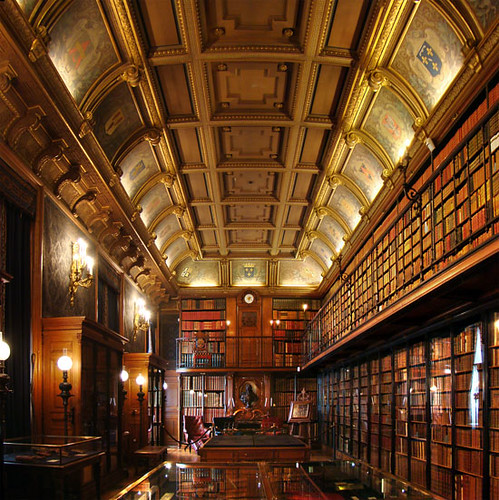
www.thebestcolleges.org/amazing-libraries/
Ganz Wins Re-Election
David L. Ganz send this personal news:
On November 8th, I was re-elected to a 4th three year term as a Bergen County Freeholder. Against some long odds (for our party got its clocked cleaned last year, losing three freeholder seats, the county executive and the sheriff), I ran for reelection and we swept on a county-wide basis: two freeholders, the Surrogate Judge and the County Clerk.
As you may know, Bergen County is larger in population than six states (five plus D.C.), and freeholders run at large in the county with 70 towns and a population over 900,000 people. Of course, I still practice law in NY and have found time to write a number of books on a variety of topics over the last couple of years.
In January, though in the minority, I will be the freeholder with greatest longevity (10 years). Though this has been a busy year campaigning, I wrote a book for Krause Investing in precious metals (gold, sliver, platinum and palladium) that will be out December 27th) and am working on one for Zyrus on national parks that will be out early next year. I believe that these will be my 32nd and 33rd books or book-length topics.
MIMI BIZIC AND THE HOBO NICKELS BOOK
A few weeks ago, I wrote about hobos riding the rails on both sides of the Ohio River and those who, like me, saw them first hand.
That mention brought back some other memories for Mim Bizic of Moon Township, a former teacher and librarian at Edgeworth Elementary School in the Quaker Valley School District. During her years of teaching, she highlighted many different subject matters. One year on Veterans Day, about 50 veterans and I who could squeeze into our uniforms spoke at a school assembly about our World War II experiences.
Another area of interest was in numismatics coin collecting. Back in 1981, noted collector Del Romines traveled 450 miles at Bizic's request from Kentucky to Edgeworth Elementary. He was pleasantly surprised to find such a receptive audience in Bizic's fourth-grade class as he talked about regular coins, error coins and some unusual coins made by a 5-foot-4-inch black hobo, George Washington Hughes, better known as "Bo."
Bo's talent was reworking the stoic Indian nickel designed by James Frazier into jockeys, clowns, friends, famous faces, presidents and self portraits. His "hobo nickels" works have become some of the most sought-after unique items of numismatic interest.
The enthusiasm shown by the students brought attention to them, Romines and "Bo." There were stories in national publications such as Numismatic News and Coin World. There were also newspaper articles in the Sewickley Herald by Joe Smith and Mike May. Smith wrote on March 4, 1981, that "it all goes to show how far enthusiasm can go in this case all the way from Louisville to Edgeworth."
Mara Meisel had a story, "Book Traces Hobo Nickels Wandering History," in the Pittsburgh Press and said "that a nickel wouldn't go far today, but during the Depression an artistic hobo could turn a nickel into a meal or extra cash by re-carving the surfaces of the buffalo nickel." Romines also appeared on Cathy Milton's WTAE-TV show with Bizic and students from her class and at their insistent prodding, he decided to write an extensive resources book about hobo nickels. The book, "Hobo Nickels," made its debut in Boston at the meeting of the American Numismatic Association. Listed among the acknowledgments in the front of the book are Bizic and her class.
To read the complete article, see:
Former teacher introduced students to hobo nickels
(www.timesonline.com/columnists/gino_piroli/former-teacher
-introduced-students-to-hobo-nickels/article_
2aa8bad6-366f-5cf2-a811-34211872e72c.html#.Tsmr-sOBq0s)
QUIZ ANSWERS: RAY WILLIAMS' MYSTERY MARKS
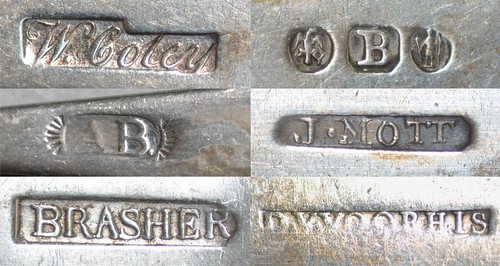
Last week I wrote:
Ray Williams supplied the above image at my request. Who can tell us what these marks mean, and their numismatic significance? For extra credit, what do they all have in common? More next week.
Pete Smith writes:
What are Ray Williams' mystery marks? They are silversmith marks.
What do they mean? They were used to mark the maker of silver items and to verify correct silver composition.
What do they have in common? They were all marked on silver items.
What is their numismatic significance? That part I haven't figured out.
John Burns wrote:
DOHHHHHHHHHHH!!!!!!! Mark me down as first ......even if I'm not.
A more cogent response came from Roger Siboni, who writes:
They are Silversmith Hallmarks. Each hallmark is from a smith who engraved Colonial coins.
Kay Olson Freeman provided the best answer yet. She writes:
They are all the names or marks of American silversmiths. They all worked in "coin silver" before the American sterling silver standard was used. Each silversmith made coins or tokens in addition to usual spoons, bowls etc. What is shown in the photos should be called maker's marks (or pseudo-hallmarks) and not hallmarks, as America did not have a central hall where silversmiths took their work to be assayed for fineness - such as was done in England since the 14th Century. I am making this pedantic point now in case anyone calls them "hallmarks."
Ray Williams writes:
We all have some family traditions, and I'm sharing with you a tradition I started at Thanksgiving about a decade ago. I actually use these spoons once a year, at my Thanksgiving table, and it is the price of the food for those present to listen to a little bit about of the history of these colonial silversmiths. All of them have a numismatic connection to our colonial times. Happy Thanksgiving!

Ray provided these details:
Here's a list of the silversmiths:
1) William Coley. NY, NY.
2) Abel Buell. New Haven, CT.
3) Ephraim Brasher. NY, NY.
4) Theophilus Bradbury. Newburyport, MA.
5) James S. Mott. NY, NY.
6) Daniel Van Voorhis. NY, NY
Coley and Van Voorhis were involved in the VT Copper coinage in NYC.
Abel Buell did many things but I remember him for his connection to CT Coppers. Brasher is legendary.
Brasher needs no introduction as he's famous for the doubloon.
James Mott is of the Mott family responsible for the Mott Token, which I personally think is a Hard Times Token (no proof)
Bradbury was an apprentice to Jacob Perkins in Boston. Perkins was responsible for some of the MA Copper dies and on either side of the "B" you can see the Native American with bow and the Eagle, both are depicted on the MA Cents and Half Cents. I have a couple Bradbury spoons. I also have a British spoon that has Geo III bust as part of the identifying marks. Also, I have a ladle that has a Queen Anne Shilling embedded in the bottom, the bowl was made most likely from a William III Crown and the handle is made from a twisted piece of baleen (from a whale)
THE BOOK BAZARRE
HACKNEY HOARD OF U.S. DOUBLE EAGLES TO BE SOLD
Philip Mernick writes:
The hoard of US double eagle coins found in East London in 2007 (and recently discussed in The E-Sylum) will be auctioned by Morton & Eden later this month (Lots 212 to 222).
Putting bullion coins into auction is usually a bad idea as the auction house's commission will probably exceed the profit a respectable bullion dealer might take. These coins, however, have a history, so it will be interesting what they, and in particular, the bulk lot make (after deductions), compared with their bullion value on the day.
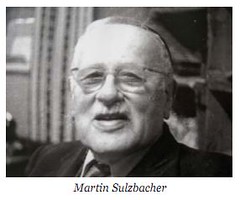 In 2007 a glass storage jar containing eighty gold US double eagles was unearthed during excavations for a new pond in gardens at the former site of 126 Bethune Road, Hackney. The find duly became the subject of a formal Treasure enquiry as well as research by local historians, with the most unusual result that the heirs of the original owner, Martin Sulzbacher, were traced and the coins restored to them. One
coin of 1908 has been donated to the Hackney Museum (where it is displayed with the jar in which the hoard was found), whilst two further
coins dated 1888 S and 1913 have been retained by the Sulzbacher family. The balance of 77 pieces is offered here.
In 2007 a glass storage jar containing eighty gold US double eagles was unearthed during excavations for a new pond in gardens at the former site of 126 Bethune Road, Hackney. The find duly became the subject of a formal Treasure enquiry as well as research by local historians, with the most unusual result that the heirs of the original owner, Martin Sulzbacher, were traced and the coins restored to them. One
coin of 1908 has been donated to the Hackney Museum (where it is displayed with the jar in which the hoard was found), whilst two further
coins dated 1888 S and 1913 have been retained by the Sulzbacher family. The balance of 77 pieces is offered here.
In October 1938, shortly before Kristallnacht, Martin Sulzbacher left Germany with his family to join his brother Fritz, who had emigrated to England some 5 years earlier, in London. A German Jewish banker from Frankfurt, Martin held some of his savings in gold and was able to buy a house in Bethune Road to which he moved with his parents, wife Hannah and their four young children in early 1939. He was able to help other family members too, notably his sister and her children after her husband had been sent to Dachau and who was never to be seen again. An unknown quantity of gold coins was kept in a City safe deposit box as savings.
On the outbreak of war in September Martin Sulzbacher a recent refugee from Germany - was classified as an enemy alien and was embarked for Canada aboard Arandora Star. She was torpedoed by a U-Boat off the coast of Ireland but Martin, a strong swimmer, survived. He was sent instead to Australia whilst his wife and their two youngest children were interned on the Isle of Man, later to be joined by the two older sons who were sent to school in Bedfordshire. Martin's parents and widowed sister were allowed to remain in London with Fritz and his family, Fritz having successfully obtained British citizenship early in 1939.
Fritz took the decision, on his brother's behalf, to withdraw Martin's gold coins from the safe deposit box and to bury them in the garden at Bethune Road. Nazi invasion was a sufficiently real threat in the summer of 1940 for this to seem prudent, and the five family members then resident in London all knew the secret of where the gold was hidden. As Fritz told a family friend, it seemed impossible that this knowledge would be lost but so it was to prove, with all five individuals being killed during the Blitz in September, 1940 when the Bethune Road house was completely destroyed.
In due course Martin and all the surviving members of the Sulzbacher family were released from internment and were able to settle in London. On finding the safe deposit box bare apart from a single gold sovereign, he naturally arranged for a metal detector search for the coins but this proved fruitless. The money seemed lost until, in 1952, a single jar of coins was recovered during the final demolition and clearance of the bombed house. The family's lasting view that there was probably more gold was confirmed when Terence Castle discovered this jar, some 2 feet down in the ground, in 2007.
Several accounts of the Sulzbacher family's story exist and the hoard has been the subject of a filmed documentary. Plans for the sale proceeds include the restoration of memorials to the five family members who were killed in 1940.
To view the complete auction catalog, see: www.mortonandeden.com/pdfcats/52web.pdf
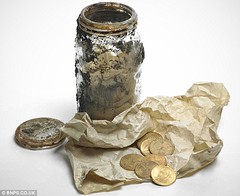 A jar of gold coins dug up in a London garden nearly 70 years after it was buried to hide it from the Nazis is set to sell at auction for £80,000.
A jar of gold coins dug up in a London garden nearly 70 years after it was buried to hide it from the Nazis is set to sell at auction for £80,000.
A family of Jewish refugees who fled Germany for England before the start of World War II buried the coins because they feared their money would be seized in a Nazi invasion. However, the family was later killed by a direct hit in an air raid during the Blitz and the exact location of the coins was lost.
But after nearly 70 years in the ground, the so-called 'Hackney Hoard' of U.S. Double Eagle gold coins was unearthed when householder Terence Castle dug a pond in his garden. Realising the significance of his find, honest Mr Castle notified the local representative of the Portable Antiquities Scheme (PAS), Kate Sumnall, who in turn passed them on to the British Museum.
An inquest by the coroner for Inner St Pancras in April this year ruled that the gold should be returned to its rightful owner.
Amazingly, a descendent of the original owner was found and Max Sulzbacher, 81, was proved at the inquest to be the rightful owner of the coins. Now that ownership has been established, Mr Sulzbacher is selling the collection of $20 coins at auction.
Auctioneers Morton and Eden is selling the coins in association with Sotheby's in London on November 29-30. One of the coins has been presented to the Hackney Museum and the family are keeping two of them.
To read the complete article, see:
(www.dailymail.co.uk/news/article-2062304/Hackney-Hoard
-auction-Rare-gold-coins-hidden-Nazis-Blitz-expected-fetch-80k.html)
Philip Mernick adds:
Having seen a copy of the Morton & Eden catalogue I find that the buyer pays 22% on top of sale price and presumably they take something from the seller as well. Definitely not the way to sell bullion.
There are 77 coins being offered. A U.S. double eagle contains almost one ounce of gold (0.9675 troy oz according to a quick internet search). Another lookup shows a troy ounce of gold selling at $1,732. At those numbers I calculate a value of $129,000 At today's exchange rate, one GBP is worth 1.5807 dollars, so the 77 gold coins contain about £81,000 in gold. I don't know If the article's £80,000 estimate is before or after the 22%+ fees, but a 22% premium isn't out of the question for coins with an interesting story behind them. We'll see how this all plays out, but perhaps they'll be offered one day at a 100-200% markup over bullion value. -Editor
THE EURO'S STRANGE STORIES
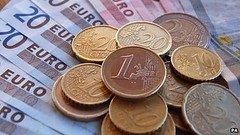 Amid all the macro-economic debate about the euro, which most of us, frankly, don't understand a word of, amid all the talk of bailouts and bonds, defaults and double-dips, no-one has had much to say about the hard cash itself. I mean, what you actually see on the euro banknotes, and in particular on the euro coins.
Amid all the macro-economic debate about the euro, which most of us, frankly, don't understand a word of, amid all the talk of bailouts and bonds, defaults and double-dips, no-one has had much to say about the hard cash itself. I mean, what you actually see on the euro banknotes, and in particular on the euro coins.
Take a closer look at those heads-and-tails and you'll find some rather disconcerting angles on European history and politics - and a story that goes back to the very first attempt at a European monetary union, 2,500 years ago.
Ironically, given what's been happening in the past few months, that prototype eurozone was masterminded by the Greeks, in ancient Athens, in the middle of the 5th Century BC.
Athens in the 5th Century BC was a democracy (the world's first, so the modern Greeks rather dubiously claim). It was also an exploitative empire, controlling many other states around the Mediterranean.
Some time about 440BC, the Athenians decided to make all these people get rid of their own currency, with their own national emblems, and use Athenian "owls" instead - in fact some of the public notices laying this down, still survive, inscribed on stone around what was the Athenian empire.
The rules, as we can read, were pretty stringent: it wasn't only money that was involved but Athenian weights and measures too (it was the ancient equivalent of imposing grams and metres as well as the euro); and the subject states had to bring their coins to be changed in Athens, with a substantial rake-off for the Athenian treasury. Non-compliance could result in the loss of citizenship; it might even lead to the death penalty.
Modern historians have puzzled endlessly about what was really going on here. Were the Athenians out simply to make a profit? Were the states of the empire actually keen to come into the Athenian-zone? If so, threats of the death penalty seem a bit unnecessary.
And did the legislation actually succeed in eradicating the other currencies and establishing the owls across the empire? We can't be sure.
But on any interpretation, it is hard to resist the conclusion that the Athenian imperialists were using monetary union to display their political muscle - and hard not to imagine that vengeance for that has finally come, 25 centuries later.
To read the complete article, see: A Point of View: The euro's strange stories (www.bbc.co.uk/news/magazine-15790507)
KOLBE & FANNING NUMISMATIC BOOKSELLERS WEBSITE
NUMISMATICS IN THE BASEL HISTORICAL MUSEUM'S NEW EXHIBITS
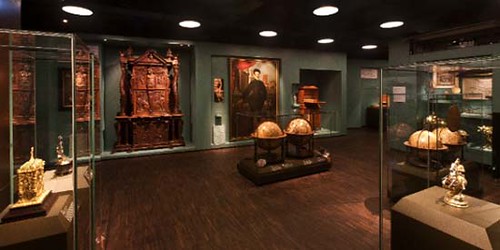
Basel Historical Museum's new permanent exhibition in the basement of the Barfόίer Church has opened on 13th November, concluding the most important milestone in the modernization of the museum. With 1200 square metres of state-of-the-art exhibition space at its disposal, the museum has been able to redesign its permanent exhibition from the ground up. The new show appropriately titled "Understanding the World" reveals how perceptions of the world change over time and invites visitors to take a fresh look at its superb collection.
Works of art, scientific artefacts and objects of everyday use tell us a lot about how people perceive the world. While the Basel tapestries from the Late Middle Ages depict alternative fantasy worlds, the cabinets of curiosities in which 16th-, 17th- and 18th-century collectors amassed objects from all fields of study paint a vivid picture of what was already known about the real one. While coins and medals have been telling us about peoples and cultures for more than two and a half millennia, the archaeological excavations conducted since the Renaissance have greatly added to our knowledge of ancient civilizations and lost worlds.
A World in Small The Great Cabinet of Curiosities: Several major collectors in Basel between the 16th and 18th century created "a world in small" for their own private enjoyment.


Medal: Erasmus von Rotterdam, Quentin Massys (Leuven c. 1456-1530 Antwerp), dated to 1519
The theme of collecting is introduced by the estate of Erasmus of Rotterdam, which following his death in Basel in 1536 became the rootstock of the Amerbach Cabinet.
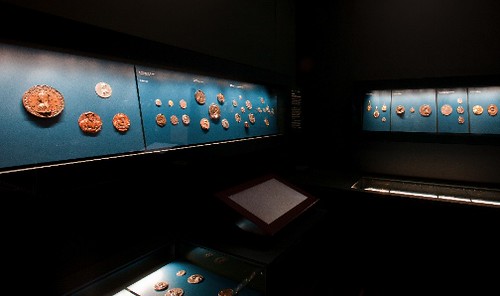
The Great Cabinet of Curiosities is also the fulcrum leading to two adjoining sections: the Burgundian Booty and a collection of coins and medals, which as legal tender and miniature works of art cover a longer time span and a larger geographical compass than any other group of objects in the museum. The coins presented here under the heading "The World's History in Your Hand" tell us a lot about times past, while the focus in the case of medals is on their function as works of art and propaganda immortalized in metal.
To read the complete article, see: New permanent exhibition at Basel Historical Museum (www.coinsweekly.com/en/News/4?&id=877)
IS THAT $1.50 COIN WORTH $1,500?
ONLINE TRANSACTION FIRM DWOLLA SIDESTEPS CREDIT CARD NETWORKS
There's a tiny 12-person startup churning out of Des Moines, Iowa. Dwolla was founded by 28-year-old Ben Milne; it's an innovative online payment system that sidesteps credit cards completely.
Milne has no finance background, yet his little operation is moving between $30 and $50 million per month; it's on track to move more than $350 million in the next year. Unlike PayPal, Dwolla doesn't take a percentage of the transaction. It only asks for $0.25 whether it's moving $1 or $1,000.
We interviewed Milne about how he is building a credit card killer and Square rival from the middle of the nation where VCs and press are scarce.
BI: We hear you're making credit card companies angry. How are you doing that? Ben Milne: Ultimately we're trying to build the next Visa, not the next PayPal. We're building a human network based on how we think the future of payments will work. The current model needs to be blown up.
Dwolla started out of my old company. I owned a speaker manufacturing company and we sold everything directly through a website. I got really obsessed with interchange fees and how not to pay them. Every time a merchant gets paid with a credit card they have to give up a percentage. In my case, I was losing $55,000 a year to credit card companies. I felt like they were stealing from me -- I was getting paid and somebody was taking money out of my pocket. So I thought, how do I get paid through a website without paying credit card fees? We pitched a bank, and amazingly enough they said, "We'll give it a shot."
That was three years ago, so we've been working on the project for a really long time. In December of last year we figured out how to legally do what we do.
How does Dwolla work and how is it different from PayPal?
With Dwolla, payments are made directly from your bank account. No credit or debit cards are allowed. And because they don't exist in the system, we don't have to bring the fees into the system.
You can spend any amount of money and when you do that, the person on the other end doesn't have to pay 1, 2, 3 or 4%. They only pay $0.25 a transaction, which is especially helpful when it's $1,000, $2,000 or $5,000 transactions. Obviously PayPal becomes very cost prohibitive with those larger transactions. The biggest difference between ideas like this and a PayPal and PayPal is a phenomenal idea, Square is too is that those are built on top of networks like Visa and MasterCard. We're building our own.
To read the complete article, see:
This 28-Year-Old's Startup Is Moving $350 Million And Wants To Completely Kill Credit Cards
(www.businessinsider.com/this-28-year-old-is-making-
sure-credit-cards-wont-exist-in-the-next-few-years-2011-11)
MALAWI WOMAN DELIVERS BOUNCING BABY BANKNOTE
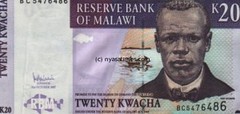 There was shock at Thyolo District Hospital female ward on Tuesday when a woman who was admitted complaining of stomach pains on the day delivered a K20 note.
There was shock at Thyolo District Hospital female ward on Tuesday when a woman who was admitted complaining of stomach pains on the day delivered a K20 note.
The lady, Faith Gama 20, who comes from Makande in came to Thyolo District Hospital on Tuesday morning after being referred from Chisoka Health Centre where she was taken for treatment.
A medical Officer who admitted the lady, Wales Mvona said she came complaining of stomach pains, but pregnancy was ruled out.
"She came in great pains. Looking at the nature of pains, we carried out pregnancy tests which came out negative and there was no other sign of pregnancy and we suspected that it may be Pelvic Inflamatory Disease so we admitted her for further help," said Mvona.
"But," he added, "It came as a shock to me to learn that the lady had delivered K20. When she arrived she had difficulties in walking, but after the delivery she was no longer in pain and was able to walk on her own."
Mvona said that he re-examined her and the pains she had in the morning had gone after the delivery of the note. He however said that there was no scientific explanation of the incident.
"When I went to re-examine her I was shown the moist bank note. But there's no scientific explanation apart from it being inserted before hand.
A nurse on duty during the delivery, Ellen Namwiyo said she saw the most bank note coming out of the woman.
"Though early tests had revealed that she was not pregnant, her pains and her stomach seemed like she had something in her stomach and she said she wanted to deliver something. When we came to her, she pushed and delivered K20 banknote that was moist," said Namwiyo.
However, her husband, Robson Gama who works at Makande Prison told said it was not the first time for his wife to deliver something strange.
To read the complete article, see:
Bizarre! Thyolo woman delivers bank note
(www.nyasatimes.com/malawi/2011/11/17/bizarre-thyolo-woman
-delivers-bank-note/)
FEATURED WEB SITE: ARTMEDAL.BE
This week's Featured Web Site is Emmanuel Van Dorpe's Artmedal site. It was mentioned last week by W.J. Elvin, albeit with a typo - the site address is artmedal.be, not artmedals.be. Sorry! There are a great number of beautiful medals pictured on the site, which includes a history of the art medal and some specialize galleries, including a nice one of dog medals.
Pisanello, a 15th century Italian artist, is widely accepted as being the father of the modern art medal. Inspired by the coins of the antiquity, he designed the first disc-shaped bifaced sculptures which we call medals.

http://artmedal.be/
